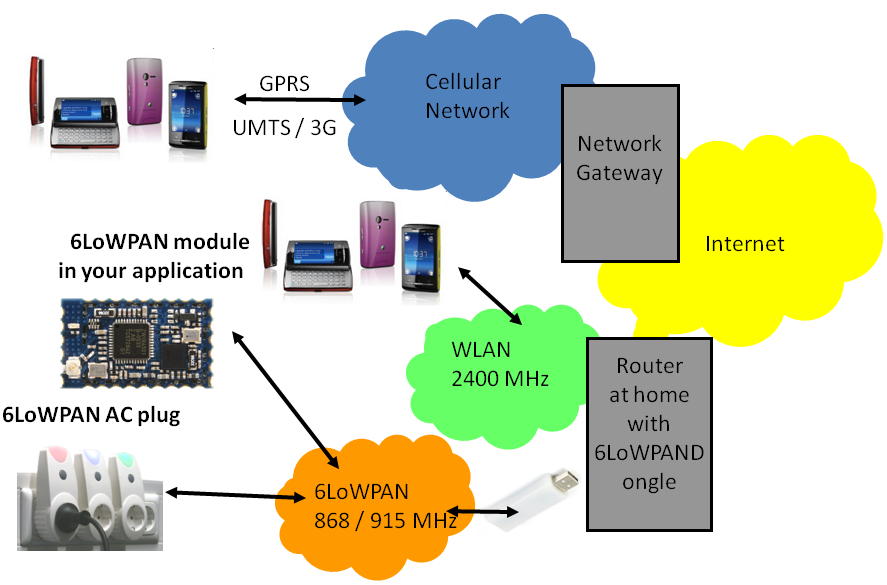6Lo… what?
This is the first reaction that you get, if you use the word 6LoWPAN. The word is not easy to speak and spell. Marketing wise is a nightmare. Anyhow, Google will use it. If Google will use the word often enough, then the people will start to remember it.
6LoWPAN meaning
IPv6 over Low power Wireless Personal Area Networks.
6 in 6LoWPAN
The 6 is used because it is based on IPv6. IPv6 is the new Internet Protocol. IPv6 has replaced IPv4, because IPv4 runs out of address range. IPv4 offers 232 = 4,294,967,296 IP addresses in the Internet.
IPv6 uses 128-bit addresses, so the new address space supports 2128 = 3.4×1038 addresses.
3.4 1038 = 3,400,000,000,000,000,000,000,000,000,000,000,000,000. This gives us 6.5 x 1023 IP addresses per square meter earth’s surface. 6.5 x 1023 = 6,500,000,000,000,000,000,000,000,000,000. Exact it is 6.5 x 1023 = 655,570,793,348,866,943,898,599.
Lo in 6LoWPAN
Lo stands for Low Power. IP communications and Low Power consumption is normally inverse. IPv4 started in 1981. Vint Cerf, the inventor planned to connect some universities together. A communication standard for 2 billion people on this nice plant was not his intention. Furthermore 30 years ago our world was not that green as it is today. We try to save power as often we can. Anyhow, we do save power because we would like to be green. We have to save power because the sensors are wireless on battery power. Nobody likes to change batteries all the time. BTW, this wireless sensors on battery forces use sometimes energy harvesting. We try to convert energy from “everything”, but this is a story for another blog post.
WPAN in 6LoWPAN
WPAN is for Wireless Personal Area Networks. A WPAN is a personal area network for interconnecting devices around a person. A popular WPAN is Bluetooth. Bluetooth is in use to interconnect our computer accessories or our audio equipment like Bluetooth headset or hands free kit. 6LoWPAN is more. In 6LoWPAN you can create meshed networks with higher distance. By using  868/915 MHz instead of 2400 MHz the coverage in buildings is much better.
6LoWPAN drawing
6LoWPAN and Google
Google published to create an Open Source radio protocol on 6LoWPAN by using the 868/915 MHz frequency range. 6LoWPAN is already license free. Google puts its protocol on top. Google selected 868/915 MHz to get higher distance. And Google promised us frequency hopping. This all is perfect and I hope that they will implement some security layers like IPsec as well. Then we will get a secure end-to-end communication from our smart-phones, laptops and tablets to our sensors at home.
6LoWPAN network
The structure can be peer to peer, star or meshed. Â It is wireless IP communication. Better said it is UDP/IP riding on a radio wave. It offers no acknowledge like TCP/IP. If the application need acknowledging then the developers of the app has to implement that feature themselves. Â BTW, by group messages it is maybe better not to acknowledge and if you plan to acknowledge then to remember the Aloha principle.
6LoWPAN conclusion
The winner will be the end user like you and me. The losers will be ZigBee, Z-Wave and all the others that are trying to sell wireless remote controlled AC-Plugs and other stuff for our Smart Home. With Google’s Android@Home and Google’s Open Source Radio Link protocol we all can decide from which party we will order our wireless equipment for our wireless Smart Home. The Babylon of tons of non necessary, proprietary, unsecured wireless protocols will end by publishing a free of charge and secure protocol by Google. Many thanks in advance to Google for this well done job.
If somebody is interested to create a 6LoWPAN network now or is interested to develop hardware or software then just send me an e-mail at harald.naumann (at) gsm-modem.de or use the form. Independent on that maybe it makes sense to follow me on Twitter, Facebook or to sign the blog posts by email. The focus of next weeks and months will be 6LoWPAN and GNSS (GPS, Galileo, Glonass) and NFC.

What type of protocols would you advise for a network range of around 3-5 meters?
If you need just a star network then Bluetooth Low Energy will be a good and cheap solution.